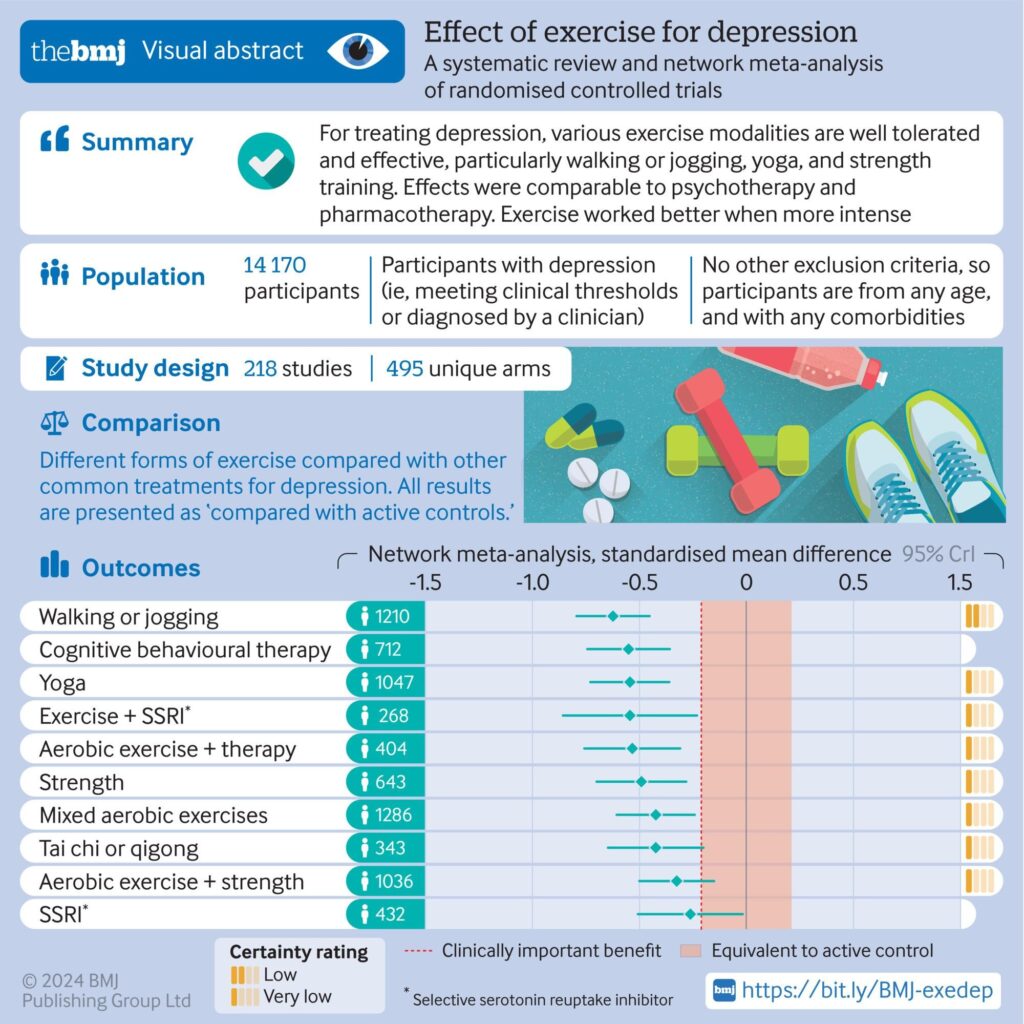The Exercise Prescription: The Optimal Type and Intensity of Exercise to Treat Depression
By Lauren DeSouza- Master of Public Health, Simon Fraser Public Research University – Canada
https://cshmke.com/our-team/
Staff Research and Content Writer
© Copyright – SUD RECOVERY CENTERS – A Division of Genesis Behavioral Services, Inc., Milwaukee, Wisconsin – January 2024 – All rights reserved.
Depression is a widespread and debilitating health issue affecting millions of Americans. A 2023 Gallup poll found that rates of lifetime and current depression reached record highs in 2023. 29% of Americans reported a lifetime diagnosis of depression, and 17.8% reported current treatment for depression. These numbers are a stark increase from 19.6% (lifetime) and 10.5% (current) in 2015.
Depression has enormous health, social, and economic costs on both an individual and a societal level. There is a variety of treatments for depression, but uptake and real-world efficacy remain low. The stigma around treatment utilization is still high despite public health efforts to change public perceptions of mental illness.
Previous research has shown that exercise has mental health benefits and can reduce the severity of depression. However, recommendations for exercise as a depression treatment remain vague. Clinical practice guidelines do not recommend any specific exercises or specify the intensity or duration of exercise needed to see improvements in depression. For example, the American Psychiatric Association simply recommends any dose of aerobic exercise or resistance training.
A new study aimed to determine the optimal dose and modality of exercise for patients with depression, with the goal of providing specific recommendations for exercise as a treatment. This is the largest study to date on exercise and depression.
What did this study do?
This study was a systematic review and network meta-analysis. In a systematic review, researchers look for all relevant research on a subject, in this case exercise and depression. The network meta-analysis combines all these studies to determine which treatment works best overall, even if they were not directly compared in any single study. The network meta-analysis was crucial in this study to compare different doses and modalities of exercise among various populations.
This review included 218 studies with 14,170 participants. The analysis investigated the effectiveness of various doses and modalities of exercise as standalone treatments for depression. It also compared exercise to other treatments for depression (psychotherapy, antidepressants, and a control condition). The researchers were also interested in seeing if the benefits of different doses or modalities of exercise differed by participants’ age, sex, or baseline level of depression.

What did the study find?
key Findings
This study had several key findings:
- All forms of exercise included in this study had a clinically significant benefit. This means they led to better outcomes or lower depression compared to no treatment.
- The benefits of exercise were equally effective for different weekly doses (e.g., exercising 3 versus 5 times a week), for patients with different underlying health conditions, and for patients with different levels of depression.
- The positive effects of exercise on depression were proportional to the intensity of the exercise. The more intense the exercise, the more benefits the patient experienced.
- Exercise may increase the effectiveness of SSRIs (selective serotonin reuptake inhibitors), a common medication used to treat depression.
Optimal Exercise
The most effective exercises identified in this study were:
- Walking or jogging
- Strength training
- Yoga
- Mixed aerobic exercise
- Tai chi or qigong

Photo by Maksim Goncharenok on Pexels
Dancing was also beneficial for easing depression, but the quality of available evidence was low. Thus, the authors cautioned against recommending dancing in clinical practice guidelines.
Patients also had preferences for certain exercises. These preferences may impact patients’ adherence to treatment and should be considered when recommending exercise as a treatment. Strength training and yoga were the preferred exercises among study participants.
Demographic differences
The meta-analysis revealed that some exercises were more effective based on participants’ age or sex. Strength training was more effective for women, whereas yoga or qigong were more effective for men. Strength training was also more effective among younger people, while yoga was more effective for older people.
What are the implications of this study?
The authors of this study have several recommendations to utilize their work to help patients with depression.
The authors encourage health care providers to recommend that patients with depression engage in exercise. Providers should especially encourage the exercises this study identified as optimal (walking or jogging, strength training, yoga, aerobic exercise, and tai chi and qigong). They should encourage patients to do vigorous exercise and to consider strength training and yoga, which were best tolerated by study participants.
Health care providers should consider exercise as an alternative or adjunct treatment for patients with depression. They should encourage patients to combine exercise with antidepressants or psychotherapy, for example SSRIs. Exercise is also a low-cost, accessible, and low-stigma alternative treatment for patients who may not want to access antidepressants or psychotherapy. However, providers should be mindful that patients may still face physical, psychological, or social barriers to exercise. Providers should be trained to provide counseling to help patients make use of exercise to treat their depression.
The authors also recommend including detailed exercise recommendations in clinical practice guidelines for depression. Specifically, they would like to see exercise recommended as a first-line option for patients with depression. This recommendation should include optimal exercises for the general population, as well as by age and sex, and should encourage people to engage in vigorous physical activity for maximum benefit.


Images via Mikhail Nilov and Mart Production on Pexels
What are the key takeaways?
- Many forms of exercise are effective in treating depression. Exercise may be as effective or more effective than antidepressants or psychotherapy.
- Vigorous exercise is more efficacious than light exercise to treat depression.
- The most optimal forms of exercise are walking or jogging, strength training, yoga, mixed aerobic exercise, and tai chi or qigong.
- Health care providers and clinical practice guidelines should recommend these forms of exercise as a first-line treatment for patients with depression.
References
Noetel M, Sanders T, Gallardo-Gómez D, Taylor P, del Pozo Cruz B, van den Hoek D et al. Effect of exercise for depression: systematic review and network meta-analysis of randomised controlled trials BMJ 2024; 384 :e075847 doi:10.1136/bmj-2023-075847
Witters, Dan. U.S. Depression Rates Reach New Highs. Gallup News. May 13, 2023. Accessed from https://news.gallup.com/poll/505745/depression-rates-reach-new-highs.aspx
